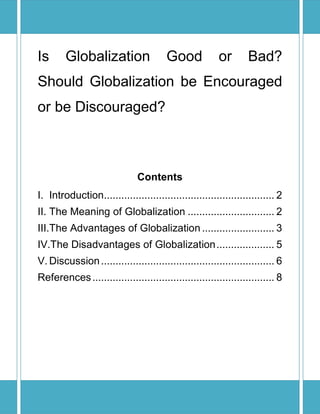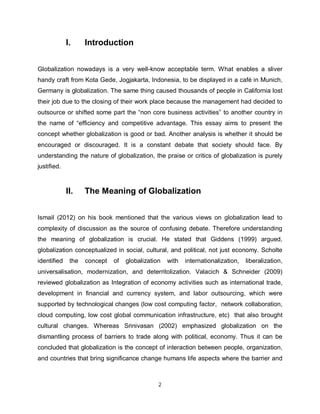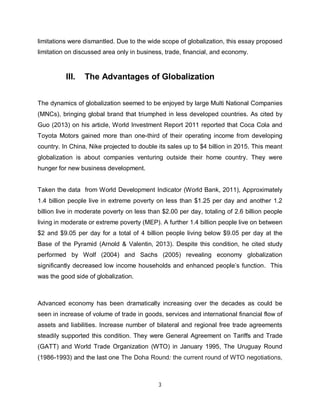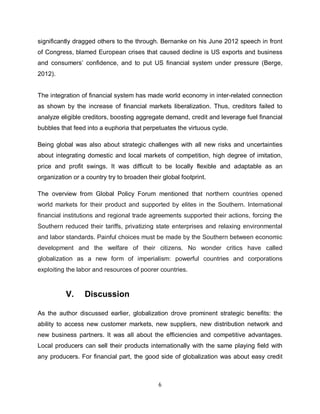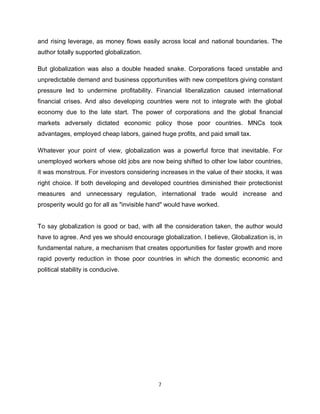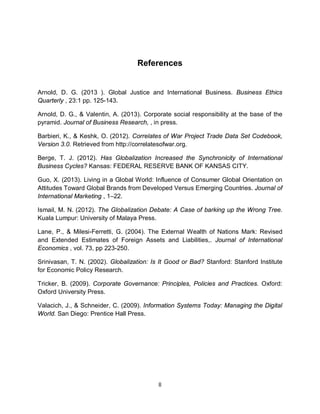International business management essay globalization
- 1. Is Globalization Good or Bad? Should Globalization be Encouraged or be Discouraged? Contents I. Introduction........................................................... 2 II. The Meaning of Globalization .............................. 2 III.The Advantages of Globalization ......................... 3 IV.The Disadvantages of Globalization .................... 5 V. Discussion ............................................................ 6 References ............................................................... 8
- 2. I. Introduction Globalization nowadays is a very well-know acceptable term. What enables a sliver handy craft from Kota Gede, Jogjakarta, Indonesia, to be displayed in a café in Munich, Germany is globalization. The same thing caused thousands of people in California lost their job due to the closing of their work place because the management had decided to outsource or shifted some part the “non core business activities” to another country in the name of “efficiency and competitive advantage. This essay aims to present the concept whether globalization is good or bad. Another analysis is whether it should be encouraged or discouraged. It is a constant debate that society should face. By understanding the nature of globalization, the praise or critics of globalization is purely justified. II. The Meaning of Globalization Ismail (2012) on his book mentioned that the various views on globalization lead to complexity of discussion as the source of confusing debate. Therefore understanding the meaning of globalization is crucial. He stated that Giddens (1999) argued, globalization conceptualized in social, cultural, and political, not just economy. Scholte identified the concept of globalization with internationalization, liberalization, universalisation, modernization, and deterritolization. Valacich & Schneider (2009) reviewed globalization as Integration of economy activities such as international trade, development in financial and currency system, and labor outsourcing, which were supported by technological changes (low cost computing factor, network collaboration, cloud computing, low cost global communication infrastructure, etc) that also brought cultural changes. Whereas Srinivasan (2002) emphasized globalization on the dismantling process of barriers to trade along with political, economy. Thus it can be concluded that globalization is the concept of interaction between people, organization, and countries that bring significance change humans life aspects where the barrier and 2
- 3. limitations were dismantled. Due to the wide scope of globalization, this essay proposed limitation on discussed area only in business, trade, financial, and economy. III. The Advantages of Globalization The dynamics of globalization seemed to be enjoyed by large Multi National Companies (MNCs), bringing global brand that triumphed in less developed countries. As cited by Guo (2013) on his article, World Investment Report 2011 reported that Coca Cola and Toyota Motors gained more than one-third of their operating income from developing country. In China, Nike projected to double its sales up to $4 billion in 2015. This meant globalization is about companies venturing outside their home country. They were hunger for new business development. Taken the data from World Development Indicator (World Bank, 2011), Approximately 1.4 billion people live in extreme poverty on less than $1.25 per day and another 1.2 billion live in moderate poverty on less than $2.00 per day, totaling of 2.6 billion people living in moderate or extreme poverty (MEP). A further 1.4 billion people live on between $2 and $9.05 per day for a total of 4 billion people living below $9.05 per day at the Base of the Pyramid (Arnold & Valentin, 2013). Despite this condition, he cited study performed by Wolf (2004) and Sachs (2005) revealing economy globalization significantly decreased low income households and enhanced people’s function. This was the good side of globalization. Advanced economy has been dramatically increasing over the decades as could be seen in increase of volume of trade in goods, services and international financial flow of assets and liabilities. Increase number of bilateral and regional free trade agreements steadily supported this condition. They were General Agreement on Tariffs and Trade (GATT) and World Trade Organization (WTO) in January 1995, The Uruguay Round (1986-1993) and the last one The Doha Round: the current round of WTO negotiations, 3
- 4. begun in 2001 in Doha, Qatar. Even an organization under UN was established, the United Nations Conference on Trade and Development (UNCTAD). Study performed by Barbieri & Keshk (2012) told us the share of global exports and imports for global GDP. Figure I. Ratio of Global Exports and Imports to Global GDP Meanwhile data taken from assessment performed by Lane & Milesi-Ferretti (2004) revealed the globalization’s contribution for the increase of share of assets and liabilities of global GDP. Then it was proven that globalization drove significant growth to international trade and financial movement. 4
- 5. Figure II. Ratio of Global Assets and Liabilities to Global GDP IV. The Disadvantages of Globalization Globalization poorly addressed as business exploitation performed by western MNCs and developing countries as the victim (Arnold & Valentin, 2013). As examples, Coca Cola made several bad track records in the countries they operated in, such as the groundwater pollution case in around its bottling plant in India and the accusation of union workers murder in Colombia (Tricker, 2009). This was because developing countries generally had few regulations to protect the environment. Eager to attract new investment, they allowed business with few or no restrictions on hazardous waste and emissions. Economic activity has the tendency to be in a cyclical pattern that could be seen as peak (expansion) and through (recession). According to the Business Cycle Dating Committee of the National Bureau of Economic Research (NBER), the arbiter of U.S. business cycle peaks and trough, a recession was normally visible in production, employment, real income, and other indicators such as real GDP, unemployment, industrial production and a retail sales index. Recession in one part of economy would 5
- 6. significantly dragged others to the through. Bernanke on his June 2012 speech in front of Congress, blamed European crises that caused decline is US exports and business and consumers’ confidence, and to put US financial system under pressure (Berge, 2012). The integration of financial system has made world economy in inter-related connection as shown by the increase of financial markets liberalization. Thus, creditors failed to analyze eligible creditors, boosting aggregate demand, credit and leverage fuel financial bubbles that feed into a euphoria that perpetuates the virtuous cycle. Being global was also about strategic challenges with all new risks and uncertainties about integrating domestic and local markets of competition, high degree of imitation, price and profit swings. It was difficult to be locally flexible and adaptable as an organization or a country try to broaden their global footprint. The overview from Global Policy Forum mentioned that northern countries opened world markets for their product and supported by elites in the Southern. International financial institutions and regional trade agreements supported their actions, forcing the Southern reduced their tariffs, privatizing state enterprises and relaxing environmental and labor standards. Painful choices must be made by the Southern between economic development and the welfare of their citizens. No wonder critics have called globalization as a new form of imperialism: powerful countries and corporations exploiting the labor and resources of poorer countries. V. Discussion As the author discussed earlier, globalization drove prominent strategic benefits: the ability to access new customer markets, new suppliers, new distribution network and new business partners. It was all about the efficiencies and competitive advantages. Local producers can sell their products internationally with the same playing field with any producers. For financial part, the good side of globalization was about easy credit 6
- 7. and rising leverage, as money flows easily across local and national boundaries. The author totally supported globalization. But globalization was also a double headed snake. Corporations faced unstable and unpredictable demand and business opportunities with new competitors giving constant pressure led to undermine profitability. Financial liberalization caused international financial crises. And also developing countries were not to integrate with the global economy due to the late start. The power of corporations and the global financial markets adversely dictated economic policy those poor countries. MNCs took advantages, employed cheap labors, gained huge profits, and paid small tax. Whatever your point of view, globalization was a powerful force that inevitable. For unemployed workers whose old jobs are now being shifted to other low labor countries, it was monstrous. For investors considering increases in the value of their stocks, it was right choice. If both developing and developed countries diminished their protectionist measures and unnecessary regulation, international trade would increase and prosperity would go for all as "invisible hand" would have worked. To say globalization is good or bad, with all the consideration taken, the author would have to agree. And yes we should encourage globalization. I believe, Globalization is, in fundamental nature, a mechanism that creates opportunities for faster growth and more rapid poverty reduction in those poor countries in which the domestic economic and political stability is conducive. 7
- 8. References Arnold, D. G. (2013 ). Global Justice and International Business. Business Ethics Quarterly , 23:1 pp. 125-143. Arnold, D. G., & Valentin, A. (2013). Corporate social responsibility at the base of the pyramid. Journal of Business Research, , in press. Barbieri, K., & Keshk, O. (2012). Correlates of War Project Trade Data Set Codebook, Version 3.0. Retrieved from http://correlatesofwar.org. Berge, T. J. (2012). Has Globalization Increased the Synchronicity of International Business Cycles? Kansas: FEDERAL RESERVE BANK OF KANSAS CITY. Guo, X. (2013). Living in a Global World: Influence of Consumer Global Orientation on Attitudes Toward Global Brands from Developed Versus Emerging Countries. Journal of International Marketing , 1–22. Ismail, M. N. (2012). The Globalization Debate: A Case of barking up the Wrong Tree. Kuala Lumpur: University of Malaya Press. Lane, P., & Milesi-Ferretti, G. (2004). The External Wealth of Nations Mark: Revised and Extended Estimates of Foreign Assets and Liabilities,. Journal of International Economics , vol. 73, pp 223-250. Srinivasan, T. N. (2002). Globalization: Is It Good or Bad? Stanford: Stanford Institute for Economic Policy Research. Tricker, B. (2009). Corporate Governance: Principles, Policies and Practices. Oxford: Oxford University Press. Valacich, J., & Schneider, C. (2009). Information Systems Today: Managing the Digital World. San Diego: Prentice Hall Press. 8

